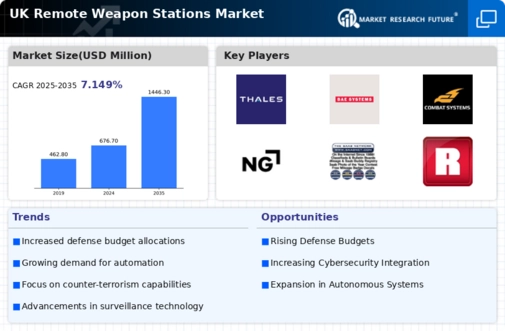Growing Security Concerns
The remote weapon-stations market is experiencing growth due to escalating security concerns in the UK. The rise in asymmetric warfare and terrorism has prompted the UK government to enhance its defense capabilities. As a result, there is a notable increase in investments in advanced military technologies, including remote weapon stations. The UK Ministry of Defence has allocated approximately £20 billion for modernization programs, which includes the integration of remote weapon systems. This trend indicates a shift towards more sophisticated defense solutions, as military forces seek to mitigate risks while maintaining operational effectiveness. The emphasis on remote operations allows for reduced personnel exposure to danger, thereby aligning with contemporary military strategies. Consequently, the growing security concerns are likely to drive demand for remote weapon-stations, positioning them as a critical component of the UK's defense infrastructure.
Technological Integration
The integration of cutting-edge technologies is a pivotal driver for the remote weapon-stations market. Innovations in artificial intelligence, machine learning, and sensor technologies are enhancing the capabilities of these systems. The UK defense sector is increasingly adopting these technologies to improve targeting accuracy and operational efficiency. For instance, the integration of AI algorithms can facilitate real-time data analysis, enabling quicker decision-making in combat scenarios. The UK government has invested heavily in research and development, with funding exceeding £1 billion in recent years, aimed at advancing military technology. This technological integration not only enhances the effectiveness of remote weapon stations but also ensures that the UK remains competitive in the global defense landscape. As these technologies continue to evolve, they are expected to play a crucial role in shaping the future of the remote weapon-stations market.
Regulatory and Policy Support
Regulatory and policy support is emerging as a crucial driver for the remote weapon-stations market. The UK government has established various defense policies aimed at enhancing military capabilities and ensuring national security. These policies often include provisions for the procurement and deployment of advanced weapon systems, including remote weapon stations. The UK Defence Command Paper outlines a commitment to investing in next-generation military technologies, with a focus on enhancing deterrence and operational readiness. This policy framework is likely to facilitate smoother procurement processes and encourage defense contractors to innovate in the remote weapon-stations market. Furthermore, the alignment of defense policies with technological advancements creates a conducive environment for growth. As regulatory support continues to evolve, it is expected to bolster the development and deployment of remote weapon systems in the UK.
Increased Military Collaboration
The remote weapon-stations market is benefiting from increased military collaboration among allied nations. The UK has been actively engaging in joint military exercises and partnerships with NATO allies, which fosters the exchange of technology and best practices. Such collaborations often lead to the standardization of equipment and systems, including remote weapon stations, across allied forces. This trend is particularly evident in the UK’s participation in multinational defense initiatives, which aim to enhance interoperability among forces. The UK Ministry of Defence has reported that collaborative defense projects have seen funding increases of up to 15% in recent years. This collaborative approach not only strengthens defense capabilities but also drives demand for advanced remote weapon systems that can be utilized across various military platforms. As military alliances continue to strengthen, the remote weapon-stations market is likely to see sustained growth.
Shift Towards Autonomous Systems
The shift towards autonomous systems is a significant driver for the remote weapon-stations market. The UK military is increasingly exploring the potential of unmanned systems to enhance operational capabilities. This shift is driven by the need for greater efficiency and reduced risk to personnel in combat situations. The UK government has recognized the importance of autonomous technologies, with investments in research and development reaching approximately £500 million annually. This focus on autonomy is likely to lead to the development of advanced remote weapon stations that can operate independently or in conjunction with manned systems. The integration of autonomous capabilities not only improves mission effectiveness but also aligns with the broader trend of modernizing military operations. As the demand for autonomous systems grows, the remote weapon-stations market is expected to expand significantly.





















Leave a Comment